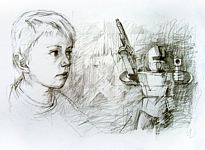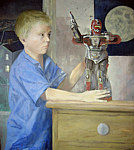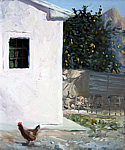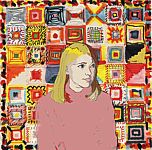Drawing
I rarely think of the drawing as an end in itself – it is usually a way of gathering information and ideas for painting. In this respect I will create studies towards a painting to help me to resolve a problem. (‘Boy and Robot‘ is an example where I tried to create a relation between the boy and his toy by allowing geometry to link them both).
I have taught drawing for many years and here, I think the value of the process is the end itself. It helps us to appreciate and understand the world around us as well as something about ourselves. It is disappointing that, in this era of visual images, we support it so little educationally at primary and secondary level. I think of diagrams, plans, maps and illusionistic drawings as all being very closely related, all part of our desire to visualise information rather than rely on the symbols of letters to string ideas together for us. The next drawing, a sort of working out of a Raphael drawing through ovals represents my interest in the great traditions of drawing and a desire to understand them, however simplistically!

|
 |

|
Drawing is the source of ideas for many of my paintings. The ideas have often come from the habit of drawing from memory at the end of the day. I keep sketchbooks of these and usually manage to sustain one drawing a day for about 6 weeks then I leave it for a few months. The drawings, whether they are slight or more developed, are often both surprising and meaningful when I look back at the sketchbooks.
I have a lot of larger drawings based in observation and these are always evocative of the time and place they were done. They are often less useful to me than the memory drawings unless they help with problems in the paintings
Sketchbooks are the main place for my drawings and they are also a sort of diary.Here, the tiniest marks based in observation can be very significant and may prompt larger ideas and images. Digital imagery is a powerful way to ‘draw’ with all sorts of source material, not just lead or ink, to manipulate. The ease with which you can draw with colour on computers is very liberating while the ability to import other material removes the distinction between collage and drawing.
My enthusiasm for drawing has always been as a teacher and a practitioner. Drawing is such a natural activity and making a mark such a natural thing to do that to lose our early enthusiasm for it is a shame – as children it was once as natural to all of us as laughing and running.
I think drawing combines thought and feeling, order and touch, in a unique way. Drawing is often an individual and private activity but the outcome can magically link that individual’s thoughts and feelings to a wide audience. It is a way of connecting the individual to the world and sharing visions and ideas on an, often intimate, human scale. It is a profoundly civilizing activity.
Roger Conlon
2006





Roger Conlon is the Associate Dean responsible for Learning Resources and Quality Enhancement. Before this post he managed Art and Design for Filton College and has had many years experience of teaching art and design within Further and Higher Education.
Roger studied Fine Art at Bristol Polytechnic and the Royal Academy Schools and has sustained a deep interest in the practice and teaching of drawing and painting throughout his career. His belief that drawing is a natural activity related to the sense of touch and desire for order has led him to devise new approaches to teaching drawing across a variety of ages and experiences. In 2002 he co - wrote and worked as instructor and co - presenter ,with Toyah Wilcox, on a television series about drawing for HTV titled ‘Lifeclass’. More recently, he has been documenting his approach to teaching drawing with a view to publication as well as continuing to create and exhibit his own work.
His experience of art and design education at many levels has established a firm belief in its social value and the importance of the experience it offers to a wide range of students.
back